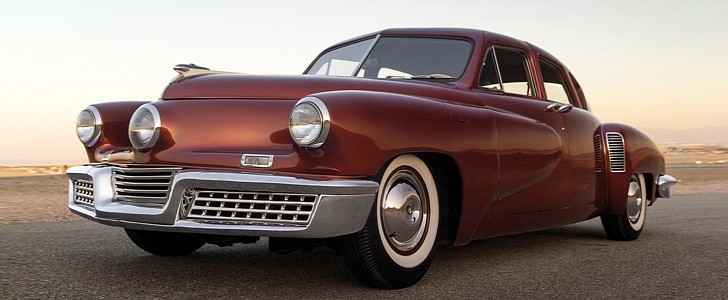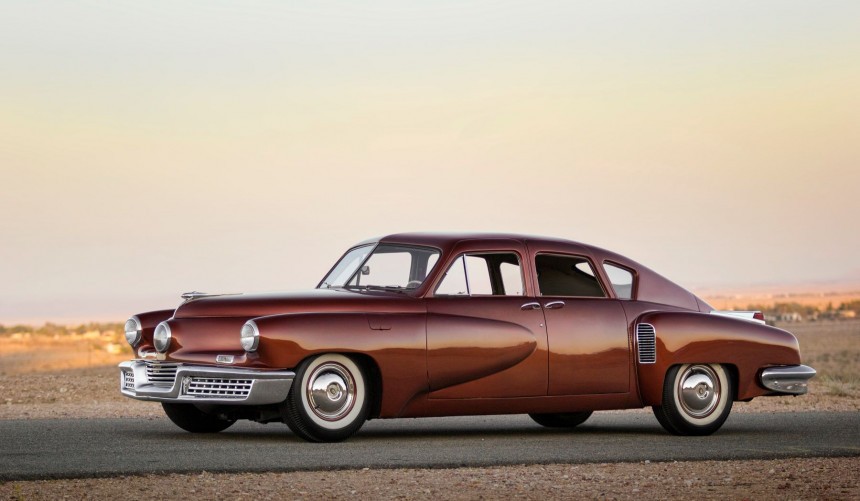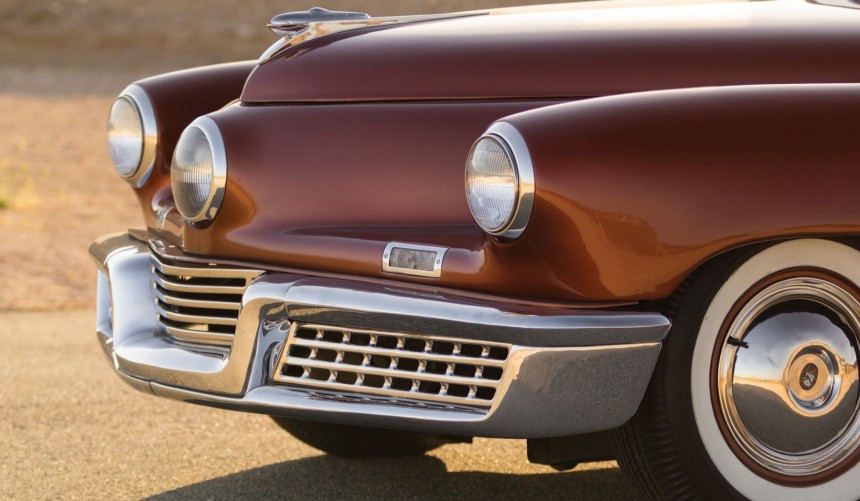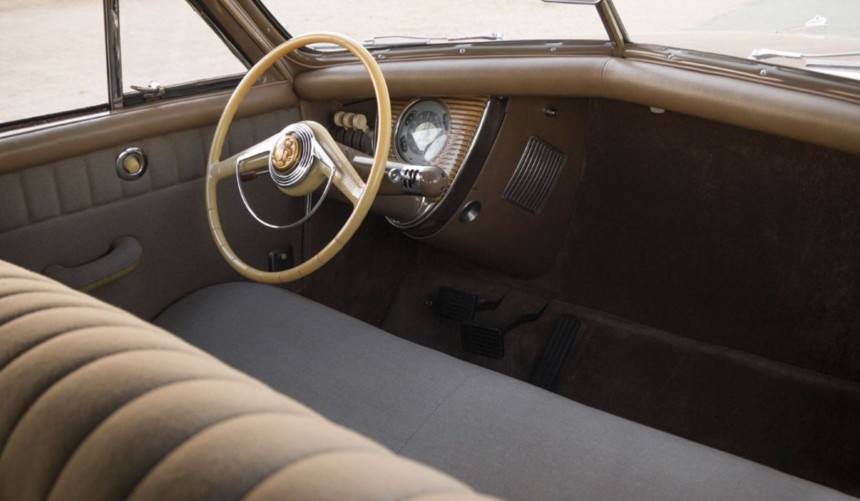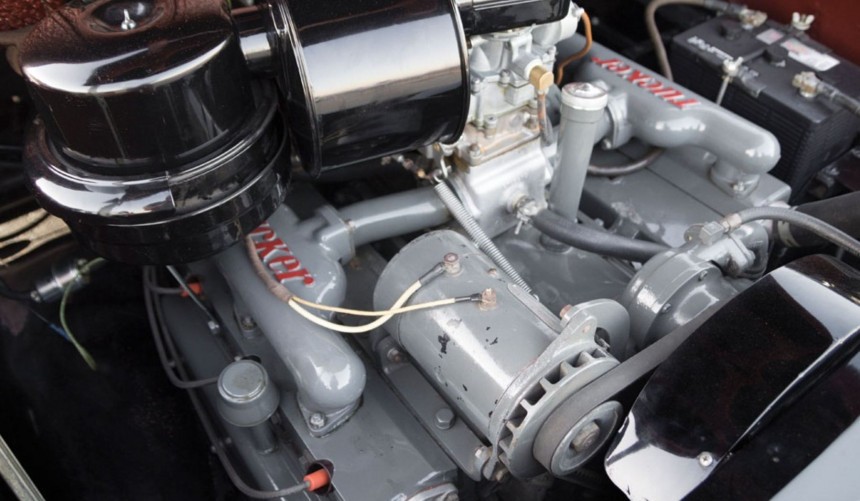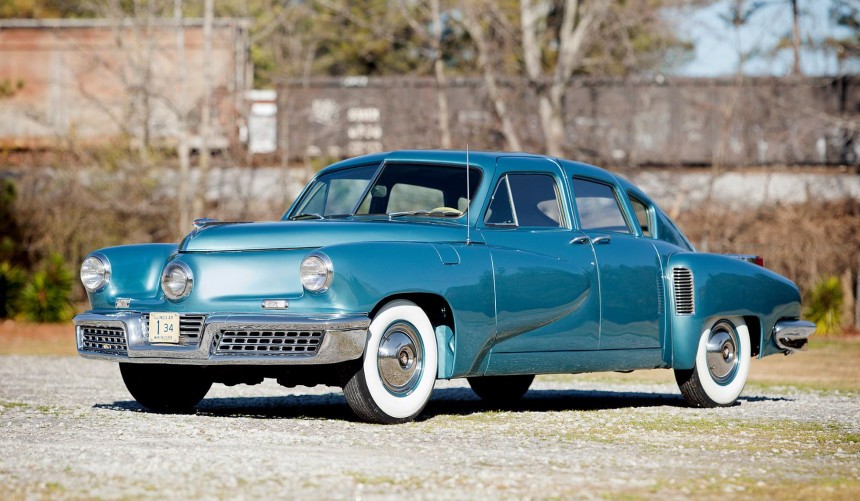Forgotten by many, the Tucker 48 was a masterpiece of 1940s automotive engineering and design. Powered by an engine initially developed for a helicopter, it introduced numerous features and ideas that became standard for American-built cars decades later.
After the end of the Second World War, the automotive market in the U.S. was beginning to show its first signs of recovery. However, Detroit’s biggest companies were in no hurry to release a new model which left the door open for smaller, independent manufacturers.
This is where we meet Preston Tucker, the visionary figure behind the legendary sedan that bore his name. The man who had spent a huge chunk of his professional career working in the automotive industry decided it would be the perfect time to introduce his masterpiece to the world.
The first design debuted in Science Illustrated magazine in December 1946 and showcased a futuristic version of the car along with a photo of a scale model titled "Torpedo on Wheels". It was actually called Tucker Torpedo, but to avoid reminding people of the war, it was ultimately renamed after the model year that was targeted for its release.
Publicly unveiled in the summer of 1947, the 48 was a pioneering vehicle the likes of which the industry had never seen.
Let’s start with the imposing body, the work of no less than nine of the era’s brightest designers. While it didn’t look drastically different from the sedans being built in the U.S at the time, it was a stunning combination of curved shapes and swooping lines that made it stand out from the crowd.
Apart from the six tailpipes, the most recognizable feature was a third headlight mounted in the middle of the front fascia that could light the car's path around corners at steering angles greater than 10 degrees. This technology was first introduced on the Czechoslovakian Tatra 77 in 1935 but only became mainstream in the auto industry several decades later.
The Tucker 48 was also a pioneering vehicle in terms of safety. For increased crash protection, an innovative perimeter frame design was employed, years before other carmakers recognized its potential. Moreover, a roll bar was integrated into the roof and the steering box was placed behind the front axle to protect the driver in the event of a front-end collision. Even the windshield was ahead of its time, being constructed from shatterproof glass and designed to pop out during a collision.
Safety-oriented elements were also present inside the cabin where the dashboard was fully padded and the instrument panel along with all the controls were placed within easy reach of the steering wheel.
There was no conventional glove box on the passenger side. Instead, storage compartments were integrated into the doors and the padded area around the dash and footwell (called a crash chamber) was reinforced to protect the occupant.
It was also one of the first cars of its era to use a four-wheel independent suspension system albeit, unlike modern systems, it employed a rubber block sandwiched between the upper and lower A-arms or rubber torsion tubes instead of coil springs.
Preston Tucker proposed several other innovations that were unfortunately abandoned during the development process. Among them, the most important were disc brakes, magnesium wheels, or self-sealing tubeless tires, all of which became indispensable for the industry decades later.
The ambitious entrepreneur initially tried to develop a revolutionary aircraft-inspired engine for his Torpedo. It was a 200-hp, 589 ci (9.65-liter) flat-six `with hemispherical combustion chambers, a fuel injection system, and oil pressure-operated overhead valves instead of a conventional camshaft. Although several prototypes were eventually built, the powerplant didn’t make it into production since it was never tuned to perfection. With time and funds running out, the company abandoned this project and opted for an O-335 made by Aircooled Motors (previously Franklin Engine Company), a company they acquired in 1947 for $1.8 million.
Developed for the Bell 47 helicopter, the unit was the closest Tucker could get to his initial plan. After his engineers ran extensive modifications to make it feasible for automotive use, the 334 ci (5.4-liter) ended up making a solid 166 hp. More importantly, it proved to be extremely reliable after being subjected to countless hours of intense testing.
While the engine itself wasn’t as innovative as initially planned, it was positioned at the rear and fed power through an adapted version of a Cord 810 four-speed manual named the Tucker Y-1, or a unique continuously variable transmission called the "Tuckermatic". Thus, it should have been the first rear-wheel-drive passenger car with a rear-mounted engine mass-produced in the U.S., a decade before the Chevrolet Corvair was introduced.
As you can see, the Tucker 48 had an overwhelming number of pioneering features which had to be perfected in a little over a year. Unfortunately, that never happened, and the early models released in 1947 and 1948 failed to live up to what was initially advertised. The media tore into the Tucker Corporation, a Securities and Exchange Commission investigation turned into a trial, losses began piling up and mass-production failed to commerce. The company never recovered and was forced to declare bankruptcy in 1949.
Including the prototypes, only 51 Tucker 48s were completed, of which 47 survive to this day. In August 2010, chassis number 1045 sold for $1.1 million, while the record-holder is the number 1043 which sold for $2.9 million at a Barrett-Jackson auction in 2012.
Those of you who would like to know more about this fantastic car should watch the 1988 movie Tucker: The Man and His Dream. Directed by Francis Ford Coppola and starring Jeff Bridges, it tells the full story of Preston Tucker and his pioneering sedan.
You can also watch the 2013 episode of Jay Leno’s Garage featured below where Tucker Club historian and restorer Martyn Donaldson showcases chassis number 1003.
This is where we meet Preston Tucker, the visionary figure behind the legendary sedan that bore his name. The man who had spent a huge chunk of his professional career working in the automotive industry decided it would be the perfect time to introduce his masterpiece to the world.
The first design debuted in Science Illustrated magazine in December 1946 and showcased a futuristic version of the car along with a photo of a scale model titled "Torpedo on Wheels". It was actually called Tucker Torpedo, but to avoid reminding people of the war, it was ultimately renamed after the model year that was targeted for its release.
That month, famed stylist Alex Tremulis was hired and given six days to come up with a production-worthy design. Tremulis achieved the impossible and just three months later, in the spring of 1947, Tucker commissioned a couple of full-page advertisements in many important newspapers announcing, “the car of tomorrow”.
Let’s start with the imposing body, the work of no less than nine of the era’s brightest designers. While it didn’t look drastically different from the sedans being built in the U.S at the time, it was a stunning combination of curved shapes and swooping lines that made it stand out from the crowd.
Apart from the six tailpipes, the most recognizable feature was a third headlight mounted in the middle of the front fascia that could light the car's path around corners at steering angles greater than 10 degrees. This technology was first introduced on the Czechoslovakian Tatra 77 in 1935 but only became mainstream in the auto industry several decades later.
Safety-oriented elements were also present inside the cabin where the dashboard was fully padded and the instrument panel along with all the controls were placed within easy reach of the steering wheel.
There was no conventional glove box on the passenger side. Instead, storage compartments were integrated into the doors and the padded area around the dash and footwell (called a crash chamber) was reinforced to protect the occupant.
Preston Tucker proposed several other innovations that were unfortunately abandoned during the development process. Among them, the most important were disc brakes, magnesium wheels, or self-sealing tubeless tires, all of which became indispensable for the industry decades later.
The ambitious entrepreneur initially tried to develop a revolutionary aircraft-inspired engine for his Torpedo. It was a 200-hp, 589 ci (9.65-liter) flat-six `with hemispherical combustion chambers, a fuel injection system, and oil pressure-operated overhead valves instead of a conventional camshaft. Although several prototypes were eventually built, the powerplant didn’t make it into production since it was never tuned to perfection. With time and funds running out, the company abandoned this project and opted for an O-335 made by Aircooled Motors (previously Franklin Engine Company), a company they acquired in 1947 for $1.8 million.
While the engine itself wasn’t as innovative as initially planned, it was positioned at the rear and fed power through an adapted version of a Cord 810 four-speed manual named the Tucker Y-1, or a unique continuously variable transmission called the "Tuckermatic". Thus, it should have been the first rear-wheel-drive passenger car with a rear-mounted engine mass-produced in the U.S., a decade before the Chevrolet Corvair was introduced.
As you can see, the Tucker 48 had an overwhelming number of pioneering features which had to be perfected in a little over a year. Unfortunately, that never happened, and the early models released in 1947 and 1948 failed to live up to what was initially advertised. The media tore into the Tucker Corporation, a Securities and Exchange Commission investigation turned into a trial, losses began piling up and mass-production failed to commerce. The company never recovered and was forced to declare bankruptcy in 1949.
Those of you who would like to know more about this fantastic car should watch the 1988 movie Tucker: The Man and His Dream. Directed by Francis Ford Coppola and starring Jeff Bridges, it tells the full story of Preston Tucker and his pioneering sedan.
You can also watch the 2013 episode of Jay Leno’s Garage featured below where Tucker Club historian and restorer Martyn Donaldson showcases chassis number 1003.
